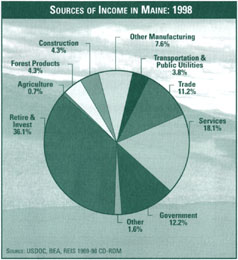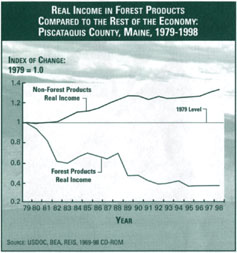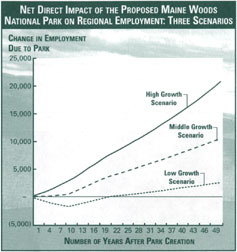|
Maine Woods National Park & Preserve Executive Summary Thomas Michael Power, Ph.D. September, 2001 The Maine Woods have long been recognized for its important biological, cultural, recreational, and economic values. In the early 1980s the State of Maine characterized the more than 10 million acres of wildlands in the Maine Woods as "the largest predominantly undeveloped area in the Eastern United States, and one of the few regions in the Eastern United States where conservation of large areas of woodland is possible." Toward this end, in 1994 the regional conservation organization, RESTORE: The North Woods, proposed the creation of a 3.2-million acre Maine Woods National Park and Preserve. According to RESTORE, The heart of the Maine Woods deserves to be protected as a new national park. As a national park, the natural wonders of the region would belong to the public. The land, water, and wildlife would be preserved as priceless parts of our national heritage, safe from exploitation. Vast wildlands would offer solitude and spiritual renewal to civilization-weary people. And the Park would strengthen local economies by creating jobs in tourism, recreation, and ecological restoration. The potential benefits of the National Park claimed by advocates have not convinced everyone. Questions have been raised about the possible cultural, social, and even environmental impacts of the proposed Park. Some of the strongest concerns have been economic.  What would the creation of such a large National Park in northern
Maine do to timber harvests and to the forest products industry
that relies on the fiber from those harvests? This report was commissioned to address these and other economic questions associated with the Maine Woods National Park proposal. Among the key findings are: The decline of forest products employment is harming the northern Maine economy. If they could, most people in northern Maine would probably choose a future similar to the past, at least the more prosperous times of the past. Generations have grown up in a region and landscape dominated by the forest products industry, which manages the land primarily for the commercial growing and harvesting of wood fiber. Over time, however, as the Maine economy has developed and diversified, the relative importance of forest products has declined. In 1998 only about 4 percent of all Maine personal income and jobs were directly derived from the lumber and wood products and pulp and paper industries combined. Employment in forest products across Maine has fallen significantly and is projected to continue to fall. Adjusted for inflation, wages in wood products, including logging, have also been in decline. The combination of dwindling jobs and declining wages has hit timber-dependent communities doubly hard.  These declines during past decades have taken place during a period of rising timber harvest. But harvest of many commercial tree species in recent years has exceeded net forest growth by a considerable margin. To stay within sustained yield, Maine forest harvests will have to be reduced. This could further accelerate the decline in forest products employment in Maine. Even if timber harvests are maintained at their current levels and improvements in labor productivity reduce employment at no faster rate that has been experienced since 1952, forest products jobs can be expected to decline by about 30 percent per decade. During the next decade that would represent a loss of 7,600 forest products jobs, 50 percent more than the 5,000 jobs lost between 1989 and 1998. The decline in forest products employment has already had a substantial negative impact on northern Maine. Aroostook, Piscataquis, and Penobscot Counties all lost population during the 1990s, mostly to out-migration. It is evident that northern Maine is not on a healthy economic and demographic trajectory. Economic recovery in Northern Maine will require diversification of the economic base. For northern Maine to reverse its economic decline and loss of population, its economy has to change. "More of the same" is neither possible nor desirable. Change in the form of diversification of the region's economic base is crucial if a more vital economy that can support at least the existing population is going to develop. Communities concerned about economic stability have little choice but to play to their strengths and uniqueness. Around the country, including in other parts of Maine, as natural resource industries have declined as sources of employment and income, high quality natural landscapes have successfully supported the development of alternative economic bases. This is amply demonstrated by the economic vitality found along the Maine Coast despite the declines in commercial fishing and other maritime industries. It is also demonstrated by the growth in neighboring New Hampshire and Vermont and in the "resettlement" of the Mountain West. For example, in the Rocky Mountain region, in rural areas with only small towns, the more of the land base in National Wilderness, Parks, Monuments, etc. the higher the measures of local economic vitality. The future economic vitality of northern Maine will partially depend on protecting the region's natural landscapes. National Parks in other rural regions have had a strong, positive impact on the local economy National Parks are usually located in rural areas where the historical natural resource industries that supported those areas in the past are often in long-term decline as sources of employment and income. In that setting National Parks have often provided a crucial economic bridge to a new, more diverse economic base that combines the down-sized natural resource industries with the economic activity drawn to the area by the same natural amenities that led the National Park to be created. Part of this is associated with Park visitation (tourism) but most of it is associated with the relocation of new permanent residents and non-tourist businesses that are attracted to the high quality environments protected by the National Park.  As a part of this study, a quantitative analysis was conducted of all of the large National Parks in the lower 48 United States. That analysis found that National Parks tend to have a strong, positive impact on local economic vitality. Specifically, job, aggregate income, and population growth rates were almost universally much higher in the counties and communities surrounding National Parks than in areas not adjacent to National Parks over the last 30 years. For example: Aggregate real income grew twice as fast as the national average.
This pattern also holds true in Maine, where the Acadia National Park region has experienced much greater economic vitality than the area of the proposed Maine Woods National Park. The creation of a Maine Woods National Park is projected to have a net positive impact on the northern Maine economy. The study concludes that the creation of a Maine Woods National Park represents an action that could contribute significantly to the transition to a more diverse and sustainable northern Maine economy. This new source of economic vitality could help to offset the unavoidable declines in the forest products sector.  The net impact of the proposed Maine Woods National Park is projected to be an additional one percent annual growth in employment in the area immediately around the proposed Park. That is a job gain of about 100 new jobs per year in the early years, rising to an addition of 300 new jobs per year 20 years later. Specifically: New residents drawn to the area by the protected natural landscapes
could be responsible directly for 3,600 jobs. These jobs would
be associated with the new businesses drawn to the area and the
normal mix of businesses that support households in any location. The decision by the public to accept or reject the establishment of a new Maine Woods National Park is a difficult one. In order to help the decision-making process, the study sought to provide a realistic assessment of the northern Maine economy. Based on this assessment, the report concludes that Maine faces a choice between two scenarios, one with and one without a National Park, both of which include declining jobs and payroll in the forest products industry. In either case, forest products is projected to be an important, but shrinking, part of the Maine economy whether or not a National Park is created. Based on the history of most existing Parks, the proposed Maine Woods National Park would probably be established over several decades. The economic impacts, both positive and negative, would not be felt suddenly but would be spread over a long period of time. This would allow adjacent communities and the state ample time to adjust productively to the economic opportunities and changes presented by the Park. In other words, the study projects neither rapid, disruptive growth nor economic collapse resulting from the creation of the proposed Maine Woods National Park. Instead, it foresees economic stabilization and gradual expansion. The character and quality of the small towns that would be gateways to the proposed Maine Woods National Park would not have to be sacrificed to crowding and overdevelopment. Experiences with existing National Parks indicate that communities can guide the growth that comes with increased economic activity. Indeed, National Parks can improve rather than damage overall quality of life. The Maine Woods National Park proposal merits further public study and careful consideration. The purpose of this study was not to recommend whether or not a new Maine Woods National Park and Preserve should be created. However, the findings of the study indicate that the Park could have significant positive economic impacts. Moreover, it concludes that many of the economic concerns that have been voiced about the National Park proposal may not be factually based. Although the conclusions of the study are preliminary, they indicate that such a Park could be consistent with the social, environmental, and quality of life concerns important to local people. Clearly, the creation of a Maine Woods National Park would have far-reaching consequences for the land and people of northern Maine. Therefore, the report recommends that a thorough, independent feasibility study of the Park proposal be conducted with the full participation of the people of Maine. This study could provide in-depth analysis of the complex issues involved, encourage additional public discussion, and promote careful consideration of all available options before a decision is made whether or not to create a Maine Woods National Park and Preserve. The Economic Impact of the Thomas Michael Power, Ph.D. The author of this study, Dr. Thomas Power, is a Professor of Economics and Chairman of the Economics Department at the University of Montana where he has taught and conducted research for almost 35 years. He specializes in natural resource economics and regional economic development. He is the author of five books, a dozen book chapters, and more than a hundred reports dealing with the economic role of natural resources in determining the economic vitality of communities. This study was commissioned by the nonprofit organization RESTORE: The North Woods and made possible by generous grants from The Moriah Fund, New England Biolabs Foundation, The Sudbury Foundation, Temper of the Times Foundation, and several individual donors. Although RESTORE raised the funds for this study, editorial control over its content and conclusions remained entirely the responsibility of the author. RESTORE did not direct or supervise the study. The opinions expressed are not necessarily those of RESTORE, the University of Montana, or the University of Montana Economics Department. A draft of the study was sent to more than forty economists, business leaders, conservationists, and Maine citizens. The author would like to thank all the individuals who reviewed the report. Their suggestions were incorporated to the maximum extent possible, and their input helped make this report more relevant to the debate about the future of Maine's forests and economy. Photos donated courtesy of Missing Lynx Photography. ----- For a copy of the full report, please contact: RESTORE: The North Woods www.restore.org ©RESTORE: The North Woods |